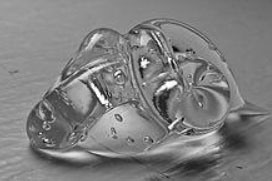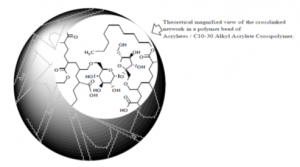Carbomer SAT- 260 ‘long flow’
| CAS-Nummer | 9003-01-4 |
| Einecs-Nummer | – |
| INCI-Bezeichnung | carbomer |
| International nonpropietary name (INN) | – |
| Artikelnummer | 445161 |
| CAS-Nummer | 9003-01-4 |
| Einecs-Nummer | – |
| INCI-Bezeichnung | carbomer |
| International nonpropietary name (INN) | – |
| Artikelnummer | 445161 |

Source Wikipedia
There is a large number of inorganic (silica, bentonite) and cellulose-based thickeners. Also acrylic acid polymers are mainly preferred in cosmetics.
Carbomers are often white, loose, hygroscopic powders. Classically, it is the polyacrylic acid carbomer type with which more than 50 years of experience are present in the cosmetic application.
The carbomer polymers are high molecular weight nonlinear polymers of acrylic acid which are cross-linked with a polyalkenyl polyether. Chemically, they are homopolymers of acrylic acids crosslinked with polyalcohol allyl ethers.
Dispersed in water, they show a pH of about 2.5. In the neutral and weakly alkaline range, the carboxyl group does form salts and can therefore bind considerable amounts of water.
Depending on the degree of polymerization and the crosslinking density, different properties can also be achieved.
Preparation: In principle, acrylic acid can be the starting material which is free-radically polymerized or also the corresponding polyacrylonitrile precursors that can be saponified. In addition, polyacrylic acids can be prepared by oxidative polymerization from acrolein and hydrogen peroxide. In a specific case, polyacrylic acid is obtained by radical polymerization from the acrylic acid in the presence of peroxides (hydrogen peroxide, peroxodisulfate, dibenzoyl peroxide), azo compounds or other free-radical formers. For copolymerization, allyl ethers of pentaerythritol or sucrose (0.75 to 2%) are used as crosslinking agents.
Use: Carbomers and their sodium salts are used in cosmetic products, in particular for emulsion stabilization and for controlling the rheological properties in concentrations of up to 50%. (Thickening) In aqueous and isopropanol-containing transparent gels, carbomer concentrations are normally 0.5%. After dispersion in water and neutralization with alkali hydroxides or amines, carbomers are clearly soluble under gel formation. The optimal pH value for the best thickening effect is, depending on the type, between pH 5 and pH 10. Some carbomers already have a relative clear thickening effect at pH 4.
The polyanionic colloid, which is initially “pounded”, undergoes a certain “deconcentration” as a result of the dispersion in water, and by “neutralization” a “stretching” of the molecules. Normally the various carbomer types are prepared using organic solvents, e.g. Benzene, ethyl acetate and cyclohexane. The residual solvent contents vary from about 0.01% to 1%, depending on the carbomer type.

Source: Kacharia Thickeners in cosmetic
The charged groups are repulsed and the chains unfold and give space for the storage of water.

Source: Kacharia Thickeners in cosmetic
The further development of the polyacrylic acid thickeners led to hydrophobically modified thickeners, where long, hydrophobic, hydrocarbon chains were incorporated by polymerisation. They are polymers of acrylic acid alkyl esters (C10-C30), acrylic acid, methacrylic acid and / or other alkyl acrylates; Cross-linked with propenyl- (allyl-) modified sugars:

Source CIR report 2011
10-30-acrylate acrylate cross-polymers show better properties in many formulations and are increasingly used. They give clearer gels and are particularly easily dispersible. In addition, they are more tolerant against surfactants and electrolytes than polyacrylic acid thickeners.
For the carbomers and crosslinked acrylic polymers, a safety assessment has been published by the CIR Panel 2011 (Crosslinked Alkyl Acrylates as Used in Cosmetics). The polymers have been classified as safe provided that they are free of benzene residues from production.
Satcotek offers exclusively carbomers which are produced without the use of aromatic hydrocarbons and are therefore safe to use.